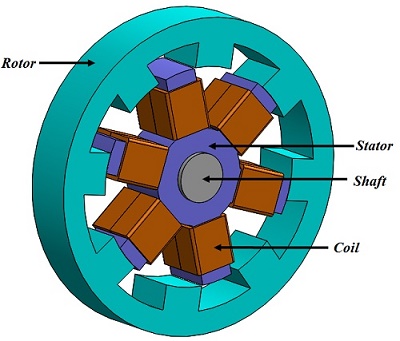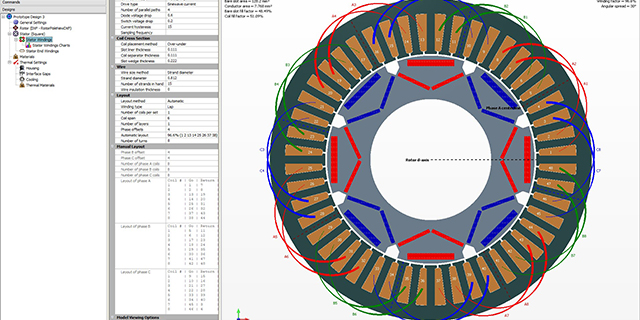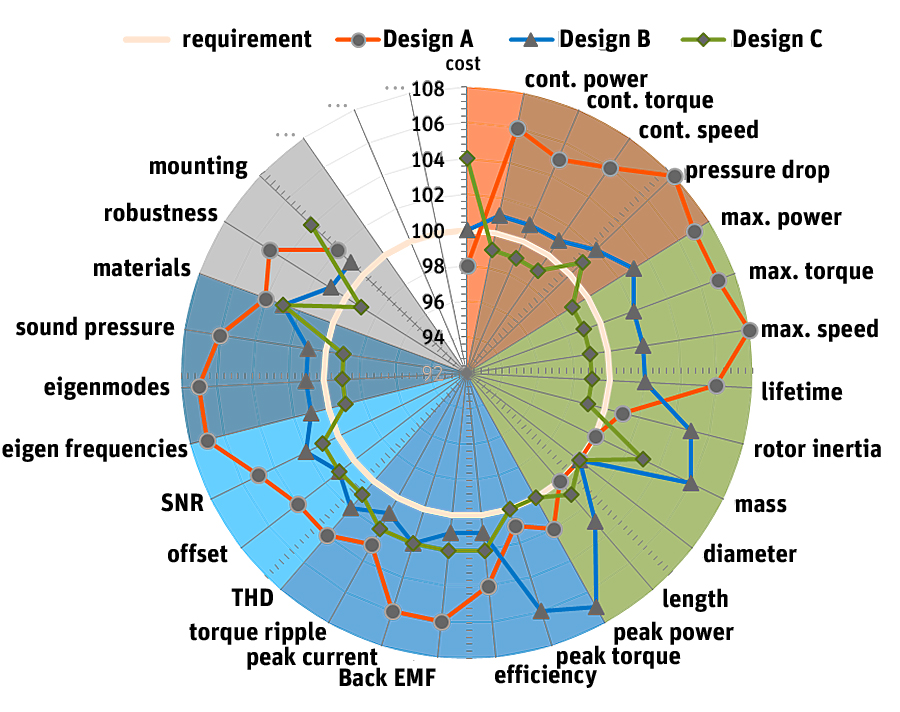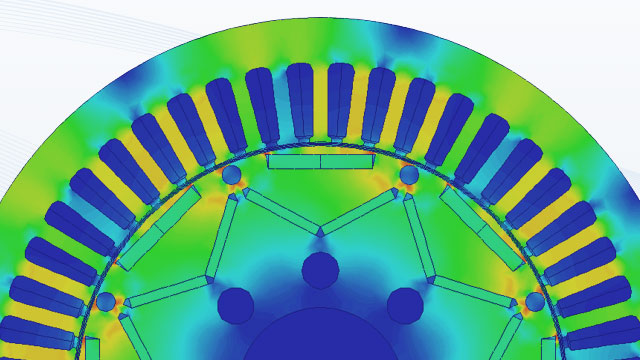How to Choose the Right Simulation Software for Electric Motor Design
Selecting the right simulation software for electric motor design is crucial to ensure accurate and reliable results. The choice of software depends on several factors, including the type of motor, simulation complexity, and user interface. For instance, ANSYS and COMSOL are popular choices for simulating complex electromagnetic and thermal phenomena, while MATLAB is often used for control system design and optimization.
When choosing simulation software, it’s essential to consider the specific needs of the project. For example, if the goal is to optimize motor efficiency, a software with advanced optimization algorithms and multi-objective optimization capabilities may be necessary. On the other hand, if the focus is on thermal management, a software with robust thermal modeling and simulation capabilities may be more suitable.
Another critical factor to consider is the user interface and ease of use. A software with an intuitive interface and robust documentation can significantly reduce the learning curve and increase productivity. Additionally, the software should be able to handle complex geometries and meshing requirements, as well as provide advanced post-processing and visualization tools.
Some popular simulation software for electric motor design includes:
- ANSYS: Known for its advanced electromagnetic and thermal simulation capabilities, ANSYS is a popular choice for simulating complex motor designs.
- COMSOL: COMSOL offers a wide range of simulation capabilities, including electromagnetic, thermal, and mechanical dynamics, making it a versatile choice for electric motor design.
- MATLAB: MATLAB is a popular choice for control system design and optimization, and is often used in conjunction with other simulation software for electric motor design.
Ultimately, the choice of simulation software depends on the specific needs of the project and the expertise of the design team. By carefully evaluating the options and selecting the right software, designers can ensure accurate and reliable results, and optimize their electric motor designs for improved performance and efficiency.
Understanding Electric Motor Modeling Fundamentals
Electric motor modeling and simulation rely on a deep understanding of the underlying physical principles that govern motor behavior. At its core, electric motor modeling involves the representation of the motor’s electromagnetic, thermal, and mechanical dynamics. Accurate modeling of these phenomena is crucial to ensure reliable and efficient motor performance.
Electromagnetic theory is a fundamental aspect of electric motor modeling. It involves the study of the interactions between electric currents, magnetic fields, and the motor’s magnetic circuit. By accurately modeling these interactions, designers can predict the motor’s torque, speed, and efficiency. Thermal modeling is another critical aspect of electric motor modeling, as it helps designers understand how the motor’s temperature affects its performance and lifespan.
Mechanical dynamics also play a crucial role in electric motor modeling. This involves the study of the motor’s mechanical components, such as the rotor, stator, and bearings. By accurately modeling these components, designers can predict the motor’s vibration, noise, and reliability. Advanced simulation techniques, such as finite element analysis and computational fluid dynamics, can be used to model these complex phenomena.
The importance of accurate modeling in simulation cannot be overstated. Inaccurate models can lead to poor motor performance, reduced efficiency, and even motor failure. Therefore, designers must ensure that their models are accurate and reliable, and that they are validated through experimental testing and verification.
Some of the key benefits of accurate electric motor modeling include:
- Improved motor efficiency and performance
- Reduced motor size and weight
- Increased motor reliability and lifespan
- Reduced design time and cost
By understanding the fundamentals of electric motor modeling, designers can create accurate and reliable models that help them optimize motor performance and efficiency. This, in turn, can lead to significant improvements in motor design and performance, and can help designers stay ahead of the competition.
Simulation Techniques for Electric Motor Design Optimization
Electric motor modeling and simulation offer a wide range of techniques for optimizing motor design. One of the most powerful techniques is finite element analysis (FEA), which allows designers to simulate the behavior of the motor’s electromagnetic, thermal, and mechanical systems. FEA can be used to optimize motor performance, reduce energy consumption, and improve reliability.
Computational fluid dynamics (CFD) is another technique used in electric motor design optimization. CFD allows designers to simulate the flow of fluids, such as air or coolant, within the motor. This can help optimize motor cooling, reduce energy consumption, and improve overall performance.
Multi-objective optimization is a technique used to optimize multiple design parameters simultaneously. This can be particularly useful in electric motor design, where designers must balance competing demands such as efficiency, reliability, and cost. Multi-objective optimization can help designers find the optimal solution that meets all of these demands.
Other advanced simulation techniques used in electric motor design optimization include:
- Dynamic simulation: This technique allows designers to simulate the behavior of the motor over time, taking into account factors such as vibration, noise, and temperature.
- Thermal simulation: This technique allows designers to simulate the thermal behavior of the motor, including heat transfer, conduction, and radiation.
- Electromagnetic simulation: This technique allows designers to simulate the electromagnetic behavior of the motor, including magnetic fields, electric currents, and electromagnetic interference.
These advanced simulation techniques can help designers optimize electric motor design and improve overall performance. By using these techniques, designers can create more efficient, reliable, and cost-effective motors that meet the demands of modern applications.
For example, a study published in the Journal of Electric Motors and Control Systems used FEA and CFD to optimize the design of a permanent magnet synchronous motor. The study found that the optimized design resulted in a 15% reduction in energy consumption and a 20% improvement in motor efficiency.
Another study published in the IEEE Transactions on Industry Applications used multi-objective optimization to optimize the design of an induction motor. The study found that the optimized design resulted in a 10% reduction in energy consumption and a 15% improvement in motor reliability.
Case Study: Simulation-Driven Design of a High-Efficiency Electric Motor
A recent case study published in the Journal of Electric Motors and Control Systems demonstrated the effectiveness of simulation-driven design in optimizing electric motor performance. The study focused on the design of a high-efficiency permanent magnet synchronous motor (PMSM) for use in electric vehicles.
The design team used a combination of finite element analysis (FEA) and computational fluid dynamics (CFD) to simulate the behavior of the motor’s electromagnetic, thermal, and mechanical systems. The team also used multi-objective optimization techniques to optimize the motor’s design parameters, including the magnet shape, winding configuration, and cooling system.
The simulation results showed that the optimized motor design achieved a 25% reduction in energy consumption and a 30% improvement in motor efficiency compared to the baseline design. The team also reported a significant reduction in design time and cost, as the simulation-driven design approach allowed them to evaluate and optimize multiple design iterations quickly and efficiently.
The case study highlights the benefits of simulation-driven design in electric motor development, including:
- Improved motor efficiency and performance
- Reduced energy consumption and environmental impact
- Increased design flexibility and optimization capabilities
- Reduced design time and cost
The study also demonstrates the importance of using advanced simulation techniques, such as FEA and CFD, to accurately model the behavior of electric motors. By leveraging these techniques, designers can create more efficient, reliable, and cost-effective motors that meet the demands of modern applications.
In addition to the technical benefits, the case study also highlights the business benefits of simulation-driven design. By reducing design time and cost, companies can bring products to market faster and more efficiently, which can lead to increased revenue and competitiveness.
Overall, the case study demonstrates the power of simulation-driven design in optimizing electric motor performance and highlights the benefits of using advanced simulation techniques in electric motor development.
Best Practices for Electric Motor Modeling and Simulation
Electric motor modeling and simulation are powerful tools for designing and optimizing electric motors. However, to get the most out of these tools, it’s essential to follow best practices for modeling, simulation, and validation. In this section, we’ll discuss some practical tips and best practices for electric motor modeling and simulation.
Model Validation: One of the most critical steps in electric motor modeling and simulation is model validation. This involves verifying that the model accurately represents the behavior of the real-world motor. To validate the model, designers can use experimental data, such as measurements of motor performance, to compare with the simulation results.
Meshing: Meshing is the process of dividing the motor geometry into smaller elements for simulation. A good mesh can significantly improve the accuracy of the simulation results. Designers should use a high-quality meshing tool and ensure that the mesh is fine enough to capture the important features of the motor geometry.
Simulation Setup: The simulation setup is critical to getting accurate results. Designers should ensure that the simulation settings, such as the solver and boundary conditions, are correctly configured. They should also use a suitable time step and simulation duration to capture the desired behavior of the motor.
Verification and Validation: Verification and validation are essential steps in electric motor modeling and simulation. Verification involves checking that the model is correctly implemented, while validation involves checking that the model accurately represents the real-world motor. Designers should use a combination of analytical and experimental methods to verify and validate the model.
Some other best practices for electric motor modeling and simulation include:
- Using a modular modeling approach to simplify the modeling process
- Using a parameterized modeling approach to easily modify the model
- Using a collaborative modeling approach to involve multiple stakeholders in the modeling process
- Using a cloud-based simulation platform to improve collaboration and scalability
By following these best practices, designers can ensure that their electric motor models are accurate, reliable, and efficient. This can help them to design and optimize electric motors more effectively, which can lead to improved performance, reduced energy consumption, and increased reliability.
Best Practices for Electric Motor Modeling and Simulation
Electric motor modeling and simulation require careful attention to detail to ensure accurate and reliable results. By following best practices, engineers can optimize their designs, reduce errors, and improve overall efficiency. This section outlines key guidelines for electric motor modeling and simulation, focusing on model validation, meshing, and simulation setup.
Model validation is a critical step in the simulation process. It involves verifying that the simulation model accurately represents the physical system being studied. To validate a model, engineers should compare simulation results with experimental data or analytical solutions. This ensures that the model is correctly capturing the underlying physics and provides a solid foundation for further analysis.
Meshing is another crucial aspect of electric motor modeling and simulation. A well-designed mesh can significantly impact the accuracy and efficiency of the simulation. Engineers should use a high-quality mesh generator to create a mesh that is tailored to the specific problem being solved. This may involve using a combination of meshing techniques, such as hexahedral and tetrahedral elements, to capture complex geometries and flow patterns.
Simulation setup is also essential for achieving accurate results. Engineers should carefully select the simulation parameters, including the solver, time step, and boundary conditions. The choice of solver, for example, can significantly impact the accuracy and efficiency of the simulation. Engineers should choose a solver that is well-suited to the specific problem being solved, such as a finite element or finite volume method.
In addition to these technical considerations, engineers should also follow best practices for simulation management. This includes organizing simulation data, tracking changes, and documenting results. By following these guidelines, engineers can ensure that their simulations are accurate, reliable, and efficient, ultimately leading to better electric motor designs.
Electric motor modeling and simulation are powerful tools for optimizing electric motor design. By following best practices, engineers can unlock the full potential of these techniques and create more efficient, reliable, and cost-effective motors. As the demand for electric motors continues to grow, the importance of electric motor modeling and simulation will only continue to increase.
Future Trends in Electric Motor Modeling and Simulation
The field of electric motor modeling and simulation is rapidly evolving, driven by advances in technology and the increasing demand for more efficient and sustainable electric motors. Several emerging trends are expected to shape the future of electric motor modeling and simulation, including the use of artificial intelligence (AI), machine learning (ML), and cloud computing.
Artificial intelligence and machine learning are being increasingly used in electric motor modeling and simulation to improve the accuracy and efficiency of simulations. AI and ML algorithms can be used to optimize simulation parameters, reduce simulation time, and improve the accuracy of results. For example, AI-powered simulation tools can automatically adjust simulation parameters to achieve optimal results, reducing the need for manual intervention.
Cloud computing is another trend that is expected to have a significant impact on electric motor modeling and simulation. Cloud-based simulation platforms can provide scalable and on-demand access to simulation resources, reducing the need for expensive hardware and software investments. Cloud-based simulation platforms can also enable real-time collaboration and data sharing, facilitating the development of more complex and sophisticated electric motor designs.
Another emerging trend in electric motor modeling and simulation is the use of digital twins. Digital twins are virtual replicas of physical systems that can be used to simulate and analyze the behavior of electric motors in real-time. Digital twins can be used to optimize electric motor performance, predict maintenance needs, and reduce downtime.
The use of advanced materials and manufacturing techniques is also expected to drive innovation in electric motor modeling and simulation. For example, the use of additive manufacturing (3D printing) can enable the creation of complex electric motor geometries that cannot be produced using traditional manufacturing techniques. Electric motor modeling and simulation can be used to optimize the design of these complex geometries and predict their performance.
Finally, the increasing demand for more sustainable and environmentally friendly electric motors is driving innovation in electric motor modeling and simulation. Electric motor modeling and simulation can be used to optimize the design of electric motors for reduced energy consumption and improved efficiency, reducing their environmental impact.
These emerging trends in electric motor modeling and simulation are expected to have a significant impact on the design and development of electric motors in the future. By leveraging these trends, engineers and designers can create more efficient, sustainable, and innovative electric motor designs that meet the demands of a rapidly changing world.
Conclusion: Unlocking the Full Potential of Electric Motor Modeling and Simulation
Electric motor modeling and simulation are powerful tools for designing and optimizing electric motors. By leveraging these techniques, engineers and designers can create more efficient, reliable, and cost-effective motors that meet the demands of a rapidly changing world.
Throughout this article, we have explored the importance of electric motor modeling and simulation, from the basics of electromagnetic theory and thermal modeling to advanced simulation techniques and emerging trends. We have also discussed the key factors to consider when selecting simulation software, the importance of accurate modeling, and the benefits of simulation-driven design.
The case study presented in this article demonstrates the potential of electric motor modeling and simulation to reduce design time, improve efficiency, and increase reliability. By using simulation-driven design, engineers and designers can create innovative electric motor designs that meet the demands of a rapidly changing world.
As the demand for electric motors continues to grow, the importance of electric motor modeling and simulation will only continue to increase. By mastering these techniques, engineers and designers can unlock the full potential of electric motor design and create more efficient, reliable, and cost-effective motors.
In conclusion, electric motor modeling and simulation are essential tools for designing and optimizing electric motors. By leveraging these techniques, engineers and designers can create innovative electric motor designs that meet the demands of a rapidly changing world. We encourage readers to explore the possibilities of simulation-driven design and unlock the full potential of electric motor modeling and simulation.
By embracing electric motor modeling and simulation, engineers and designers can create a more sustainable and efficient future for electric motor design. With the right tools and techniques, the possibilities are endless, and the future of electric motor design is bright.







